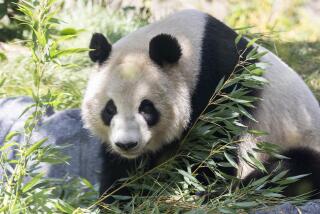Giant panda Bai Yun is artificially inseminated at San Diego Zoo
Sometimes, when nature fails, it is time for science to take over.
So it was this week for Gao Gao and Bai Yun, the giant pandas at the San Diego Zoo. The pair have had five cubs, a not inconsiderable number given the fact the female pandas are only in estrus two or three days a year and not at all during years when they are nursing.
For the first time since 2012, Gao Gao and Bai Yun were put together. But the attempted mating was not successful.
Enter the Frozen Zoo, a repository at the zoo’s Institute for Conservation Research that collects and freezes biological material from hundreds of species, many of them on the brink of extinction.
In a delicate process at the zoo’s veterinary hospital, Bai Yun was artificially inseminated Wednesday with sperm from Shi Shi, her first intended mate.
Bai Yun’s first cub, Hua Mei, the first panda cub to be born in the United States and survive to adulthood, was born in 1999 through artificial insemination with Shi Shi’s sperm. Bai Yun’s next five cubs were sired by Gao Gao, the natural way.
At 23, Bai Yun is near the end of her reproductive years. Zoo officials did not want to miss the last opportunity for Bai Yun to achieve maternity,
Gao Gao is 25. His cancerous right testicle was removed in 2014. His left testicle showed no sign of cancer, zookeepers said.
Zoo officials may soon ask the Chinese government to allow Bai Yun and Gao Gao to retire at the San Diego Zoo in emeritus, non-reproductive status. The zoo would like the Chinese to send two younger pandas to continue the breeding program.
The zoo works closely with scientists at the Wolong Reserve in Sichuan Province. Two researchers from San Diego are there at the moment.
Under the complex agreement between the zoo and the Chinese government, all of the pandas that have been at the zoo belong to the Chinese, both those that were born in China and those that were born in San Diego.
Hua Mei went to China in 2004 where she has had 10 cubs and is considered a “heroic mother” in the Chinese effort to save the iconic species from extinction.
At the zoo, Hua Mei’s name still graces the food court near the panda enclosure. She remains better known and certainly more highly regarded than most local politicians.
Despite years of study in San Diego and Wolong, much about the panda’s reproductive system remains a mystery. The males and females do not like each other and are only in proximity during those few days. Even for panda specialists, it is difficult to figure when those days are occurring.
The day after the unsuccessful attempt at mating, zoo officials decided they could not wait any longer to attempt artificial insemination. “The timing is just right,” said Carmi Penny, the zoo’s curator of mammals.
Bai Yun – at 220 pounds and four feet long from nose to tail – was given anesthesia and was sound asleep. A dozen veterinarians, physiologists, technicians and zookeepers were at her side in the surgical center at the zoo hospital. A videographer recorded the procedure for viewing by the Chinese.
Bai Yun’s underside was shaved so ultrasounds could be done on her uterus and heart. Both were fine.
Shi Shi’s sperm was chosen over Gao Gao’s. Both are on file at the Frozen Zoo but Shi Shi’s was considered more “active” and more likely to reach and fertilize an egg. Also, because he is Hua Mei’s biological father, his genes are highly rated.
The optimum time for inserting the sperm was just after it had been thawed.
After more than an hour of preparing the sedated Bai Yun, a foot-long tube with Shi Shi’s sperm was inserted into Bai Yun’s vagina by Barbara Durrant, director of reproductive physiology at the Institute for Conservation Research.
Durrant, who has been involved in numerous artificial inseminations at San Diego and other zoos, including that of Bai Yun in 1999, was pleased. “It was very easy to find the right place in the cervix,” she said.
Pandas have a process called “delayed implantation” that is only dimly understood by researchers. It will be months before zookeepers, using thermal imaging, will know whether Bai Yun is pregnant.
Sometimes science has to wait for nature.
More to Read
Sign up for Essential California
The most important California stories and recommendations in your inbox every morning.
You may occasionally receive promotional content from the Los Angeles Times.










